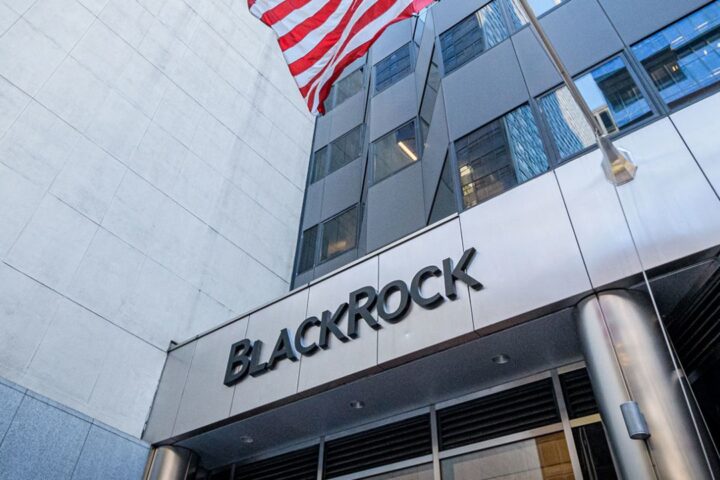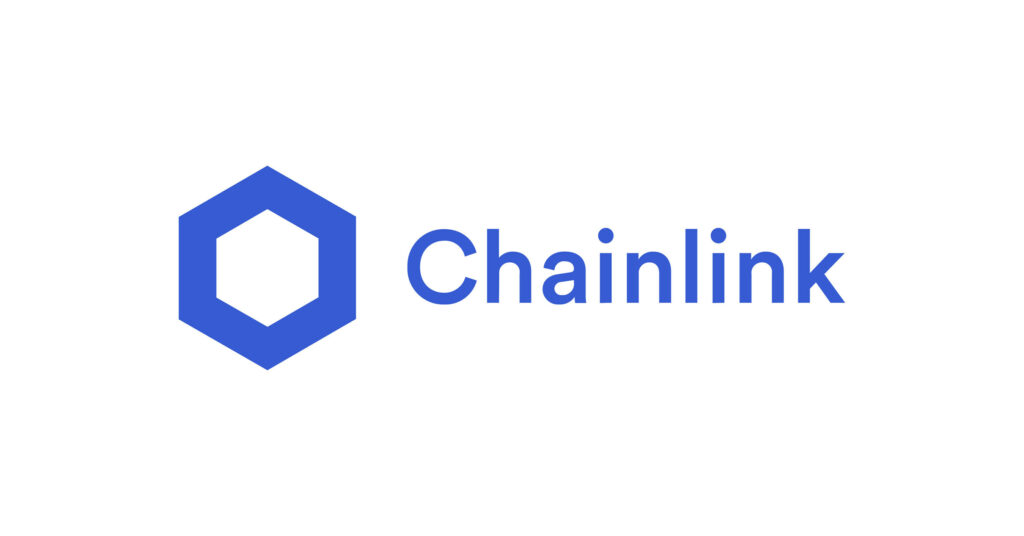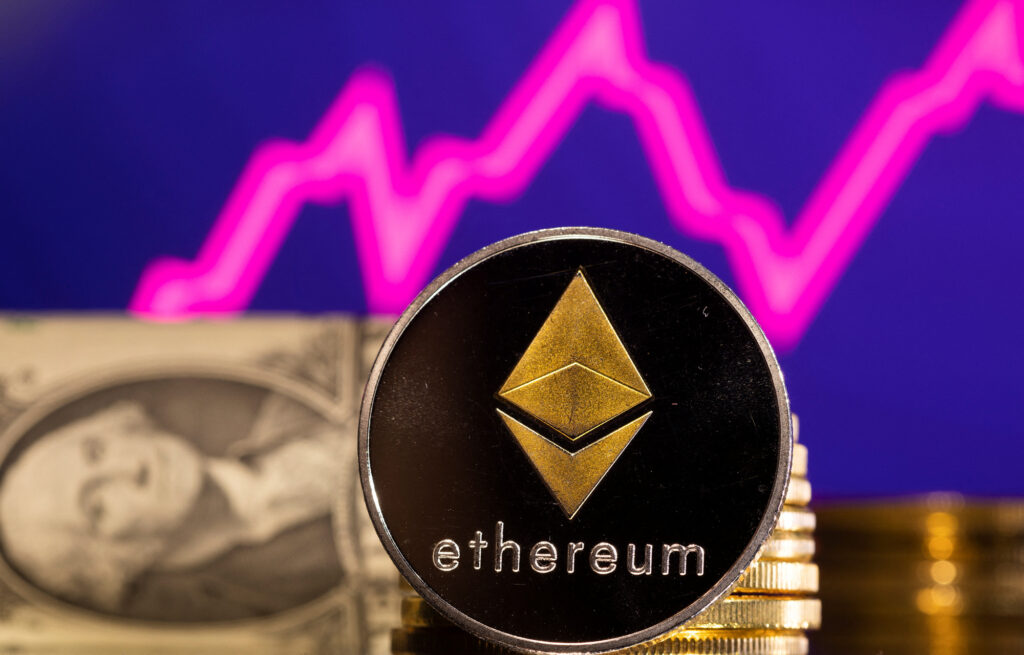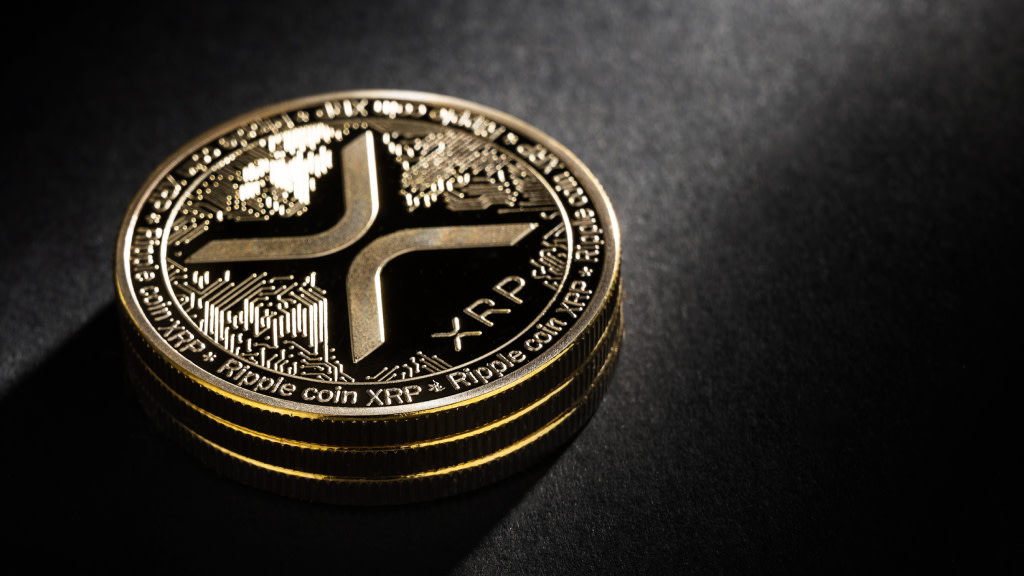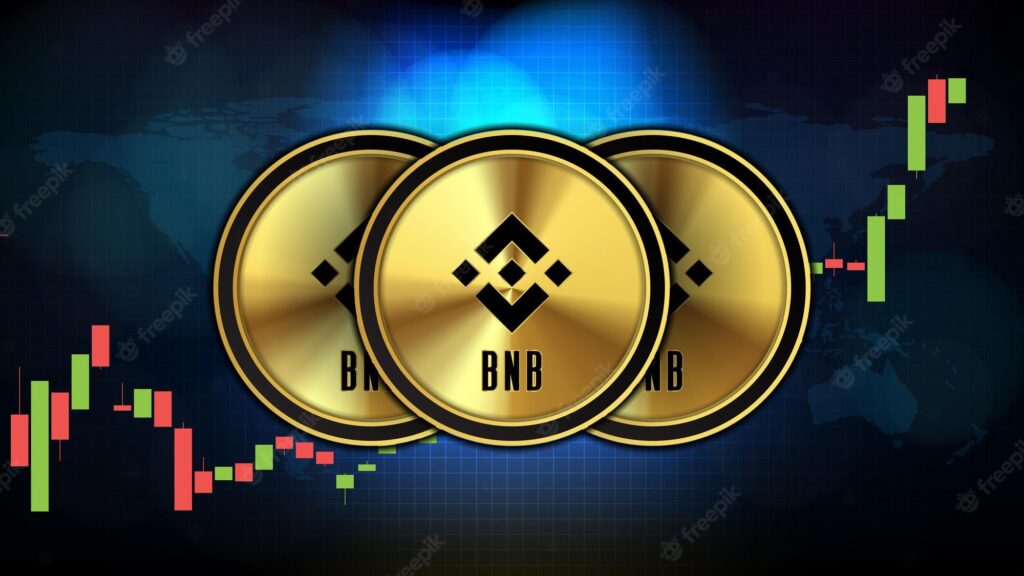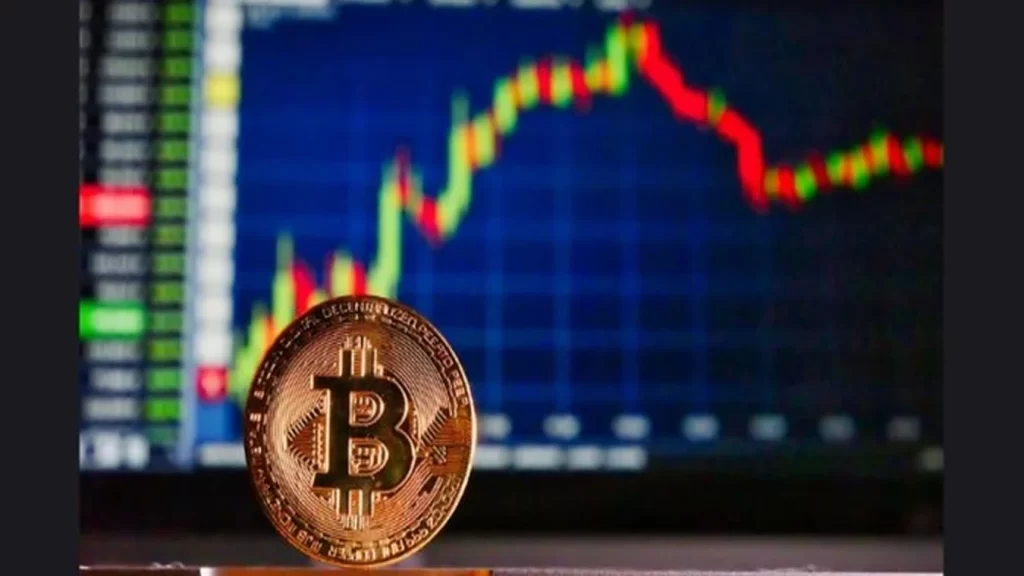The price of Avalanche’s native token AVAX surged after a newly formed company revealed plans to go public in the U.S. and acquire more than $1 billion worth of the cryptocurrency.
Avalanche Treasury Co. announced on Wednesday that it will merge with Mountain Lake Acquisition Corp., a special purpose acquisition company (SPAC), in a transaction valued at over $675 million.
The combined business intends to list on Nasdaq under the ticker “AVAT” during the first quarter of 2026, pending shareholder and regulatory approvals.
Ava Labs founder and CEO Emin Gün Sirer will join as an adviser, marking another step for institutional involvement in the Avalanche ecosystem.
This venture is only the second dedicated Avalanche-focused treasury company and reflects a broader trend of firms going public or shifting toward cryptocurrency accumulation this year.
Exclusive Relationship With Avalanche Foundation
Avalanche Treasury Co. said it has an “exclusive relationship” with the Avalanche Foundation, the nonprofit supporting the blockchain.
According to reports, the foundation has considered selling millions of AVAX tokens at discounted prices to treasury companies, providing a pipeline for large-scale acquisitions.
The company aims to hold more than $1 billion worth of AVAX following its public debut next year.
It expects its initial capital raise to produce approximately $460 million in funded treasury assets.
AVAX Price Reacts to News
The market responded quickly to the announcement.
AVAX climbed to an intraday high of $31.32 shortly after the news and remains up 2.3% over the past 24 hours, according to CoinGecko data.
Backing for the merger has come from an array of crypto-focused venture firms and companies, including Dragonfly, VanEck, FalconX, Monarq, Galaxy Digital, Pantera Capital, CoinFund, and Kraken.
Former Susquehanna Crypto CEO Bart Smith has been named the CEO of Avalanche Treasury Co., bringing traditional market-making experience to the project.
Moving Beyond Passive Holdings
Avalanche Treasury Co. emphasized that its strategy goes beyond simple token accumulation.
The company plans to generate revenue through “targeted protocol investments” and will establish its own validator infrastructure to support the network.
It also intends to help enterprises tokenize real-world assets and stablecoins on Avalanche.
“Many institutions have difficulty accessing digital assets or are limited to holding native tokens without yield or ecosystem integration,” Smith said.
“We created Avalanche Treasury Co. to offer something we believe will be more valuable than passive exposure.”
Competing for Market Share
This new company joins a wave of similar ventures.
AgriFORCE Growing Systems recently announced plans to rebrand as AVAX One and acquire $700 million worth of AVAX, reflecting rising competition for large-scale positions in Avalanche’s token supply.
Avalanche Treasury Co. stated that it will begin with an initial AVAX purchase at a discount to market price.
It also secured an 18-month priority on Avalanche Foundation token sales to U.S. digital asset treasury firms.
The company said it is targeting a multiple of net asset value (mNAV) of 0.77 — a 23% discount compared with buying AVAX directly.
However, some analysts have criticized the mNAV metric, arguing it does not accurately represent a company’s financial health.
Blockchain oracle provider Chainlink has unveiled one of the first products from its pilot with UBS Asset Management and Swift, the global financial messaging network, aimed at allowing banks to trigger onchain transactions using their existing infrastructure.
According to a Tuesday announcement, Chainlink has integrated its execution layer, known as the Chainlink Runtime Environment (CRE), with Swift messaging.
This integration means banks worldwide can now use existing Swift rails to connect to blockchain networks without building new systems from scratch.
Pilot Builds on Project Guardian
The launch expands on Project Guardian, a 2024 pilot run by Chainlink, the Monetary Authority of Singapore (MAS), and UBS Tokenize, the in-house tokenization unit of UBS Asset Management.
The project demonstrated how tokenized fund workflows could integrate with existing fiat payment systems, a key step in bridging traditional finance with blockchain-based assets.
Under the pilot, the companies used Swift’s ISO 20022 messages to carry out fund subscriptions and redemptions directly onchain.
Traditionally, these processes run through a network of custodians, transfer agents, fund administrators, and other intermediaries, each adding time and reconciliation steps.
“This interoperability unlock enables last-mile connectivity options already familiar and used by financial institutions and service providers today,” Chainlink said.
Why It Matters for the Financial Industry
According to a McKinsey report, global assets under management reached $147 trillion in June 2025, underscoring the scale of opportunity for tokenized finance.
Swift, founded in the 1970s as a Belgium-based cooperative owned by its member banks, operates the global messaging network that underpins cross-border payments.
By connecting Chainlink’s infrastructure to Swift, financial institutions can tap tokenization and blockchain settlement without overhauling their existing systems.
Swift’s Evolution in Blockchain
Swift has been working with Chainlink since 2023, running tests to show how its infrastructure could offer banks a single access point to multiple blockchains.
In September 2024, Swift joined the Bank for International Settlements and 41 private financial firms in Project Agorá, an initiative exploring how tokenized commercial bank deposits could work alongside wholesale central bank digital currencies (CBDCs) on a shared platform.
Earlier in 2024, the cooperative unveiled plans for a blockchain-based “state machine” to track transactions and balances across institutions using ISO 20022 messaging.
This system was designed to run either on blockchain or on Swift’s centralized Transaction Manager platform.
Partnerships Extend Beyond Chainlink
Swift is also collaborating with Ethereum ecosystem developer Consensys and more than 30 institutions to build a blockchain settlement system designed for round-the-clock, real-time cross-border payments.
If successful, these initiatives could position Swift at the center of tokenized finance while maintaining its dominance in traditional messaging infrastructure.
Chainlink, meanwhile, is staking a claim as a key enabler of interoperability between old and new financial systems.
Grayscale has suggested that the third quarter of 2025 may have represented a unique form of “alt season,” with altcoins outperforming Bitcoin and other major assets.
In its latest report, the asset manager noted that while cryptocurrencies across sectors posted positive returns, the pattern stood out for being distinct from traditional altcoin cycles.
“Bitcoin underperformed other market segments, and the pattern of returns could be considered a crypto ‘alt season’ — although distinct from other periods of falling Bitcoin dominance in the past,” the report explained.
Altcoins tied to smart contracts were particular beneficiaries, supported in part by the passage of the GENIUS Act in the US earlier this year.
Meanwhile, AI-related tokens and other niche sectors saw growth, while Bitcoin, Ether, and broader currency plays lagged.
Market Shifts Driven by Policy and Exchanges
Grayscale highlighted several trends that shaped Q3.
One was the growing number of corporate treasuries adding various tokens to their balance sheets.
Another was the increasing adoption of stablecoins in the United States, alongside stronger activity on centralized exchanges.
The firm argued that these elements combined to create a distinct market environment in which altcoins found momentum at Bitcoin’s expense.
Looking ahead, Grayscale speculated that pending legislation, including a digital asset market structure bill in Congress, could further support crypto markets in Q4.
Bitcoin’s Relative Underperformance
Although Bitcoin surged to a record high above $120,000 in August, its performance lagged other segments of the market.
Analysts suggested that both Bitcoin and altcoins were also trailing behind traditional assets such as gold and equities in reaching new records.
Stablecoin outflows from exchanges were cited as one factor weighing on crypto market dynamics.
This environment left altcoins better positioned to capture gains while Bitcoin’s dominance eased.
Optimism for ETFs
As a leader in crypto exchange-traded funds (ETFs), Grayscale noted that regulatory developments could provide a further boost.
The US Securities and Exchange Commission (SEC) recently approved new listing standards for digital asset ETFs.
One of Grayscale’s own products, a multi-asset crypto ETF, has already gained regulatory approval, giving investors exposure to a basket of leading assets including BTC, ETH, XRP, Solana, and Cardano.
The report concluded that optimism around ETFs and supportive legislation may sustain momentum for altcoins and the broader market heading into the final quarter of the year.
XRP gained momentum on Wednesday, rising 6.8% from Monday’s low of around $2.70.
The move came as traders adjusted following a sharp sell-off that shook the broader crypto market earlier in the week.
Technical indicators and onchain data suggested the XRP/USD pair could be preparing for a trend reversal, with a potential rally toward $4 in play.
Technical Setup Hints at Breakout Potential
XRP’s price action has been consolidating within a symmetrical triangle on the daily chart, according to data from TradingView.
This chart formation, which develops as price action compresses between converging support and resistance trendlines, often signals a breakout once momentum builds.
In XRP’s case, an upward move above the $3 resistance line could trigger a reversal toward the triangle’s projected target of $4.08, marking a potential 42% gain.
Before that target can be reached, XRP bulls will need to overcome intermediate resistance levels at $3.40 and the eight-year high of $3.66.
Traders Highlight Key Support and Resistance Zones
Analyst CasiTrades pointed out that XRP formed “a massive wick down to a double bottom near $2.70” on the four-hour chart.
“A double bottom like this still fits within a valid Wave 2 count, as long as the price holds above $2.70,” she explained in an X post.
Her analysis noted immediate downside support at $2.79, with a drop below $2.70 potentially opening the door to $2.58.
On the upside, she highlighted Fibonacci extension levels pointing to $4.00 and $4.40 as the next significant resistance zones.
“The market is preparing for a major trend shift,” she said.
Meanwhile, crypto analyst CryptoBull suggested that XRP could rally as high as $5 in October if it breaks out of a bull flag pattern currently visible on the charts.
Whale Accumulation Offers Market Support
Onchain data provided further optimism for XRP’s outlook.
Santiment’s Supply Distribution metric showed steady accumulation among wallets holding between 1 million and 10 million XRP.
These addresses added 30 million XRP over the past two days, raising their holdings to 6.77 billion tokens—about 11% of the total circulating supply.
The data indicates that large holders did not sell during Monday’s dip but instead bought more, potentially signaling confidence in higher prices ahead.
By absorbing supply on declines, these whales may help establish price floors and encourage smaller investors to follow suit.
Holder Behavior Reinforces Positive Sentiment
Further supporting the bullish case, Glassnode data revealed that XRP’s net holder position change has been positive since late August.
This accumulation trend followed weeks of profit-taking during July and early August, when XRP reached its multi-year high of $3.66.
The recent activity suggests investors are positioning themselves for further upside, particularly in the $2.70 to $3.00 accumulation range.
This buying interest highlights the importance of these levels as a foundation for future price moves.
If bulls succeed in pushing past $3.40 and $3.66, momentum could accelerate quickly toward the $4 target zone.
Avalanche’s AVAX token recorded a sharp upswing on Tuesday, rallying more than 10% to trade above $33 despite a broader downturn across the cryptocurrency market.
The move has pushed AVAX nearly 22% higher from its recent local low of $29, with institutional interest and ecosystem growth playing a central role in driving momentum for the layer-1 blockchain.
Institutional demand strengthens outlook
The Avalanche Foundation has ramped up efforts to secure institutional capital, unveiling a series of treasury-building initiatives earlier this month.
In early September, the foundation revealed plans to raise $1 billion through two separate U.S.-based crypto treasury companies, which would allow them to purchase millions of AVAX tokens from reserves at discounted rates.
One of the vehicles, steered by Hivemind Capital and advised by Anthony Scaramucci, is seeking to raise $500 million via a Nasdaq-listed PIPE transaction. On Monday, AgriFORCE Growing Systems confirmed its rebrand to Avax One and announced plans to raise $550 million to construct a treasury centered on AVAX.
A second vehicle, involving Dragonfly Capital, is also targeting $500 million through a special purpose acquisition vehicle. Together, these efforts are expected to lock up significant amounts of AVAX, applying consistent upward pressure on the token’s price.
Institutional exposure to Avalanche has also expanded through new financial products. Sweden-based Vitune launched a crypto exchange-traded product (ETP) offering Finnish investors access to AVAX in February. VanEck followed with an application to launch an Avalanche ETF in March, while Grayscale recently filed to convert its Avalanche Trust into an ETF.
This institutional wave has helped fuel confidence in AVAX, keeping its rally intact even as most digital assets retraced in recent days.
Network growth adds fuel to rally
On-chain activity has also reinforced AVAX’s strength.
Avalanche’s Octane upgrade in April reduced C-Chain fees by 98%, spurring daily transactions to 1.4 million by the second quarter, a 493% increase compared with the prior quarter. Active wallet addresses rose 57% in the same period, reaching 46,397.
In late August, Avalanche led all blockchains in weekly transaction growth, recording a 66% jump to reach a record 2.22 million daily transactions. Although activity has since moderated, counts remain robust above 1.2 million transactions daily, according to Nansen.
The total value locked (TVL) on Avalanche has more than doubled since April, climbing from $1 billion to $2.23 billion by Tuesday. Protocols like Aave, with $515 million locked, have contributed significantly. Meanwhile, the stablecoin market cap on Avalanche has soared to $2.16 billion, marking an 81% increase over the past month, according to DefiLlama.
Rising TVL and stablecoin adoption underscore the blockchain’s expanding role in decentralized finance, improving liquidity and strengthening long-term utility.
Technical setup signals bullish continuation
From a charting perspective, AVAX appears to be forming a rounded bottom pattern on the daily timeframe — a traditional bullish reversal formation.
The token has been gradually building a U-shaped base since July, when it traded near $17. A 17% jump from Monday’s lows near $29, coupled with a more than 100% spike in trading volume, suggests increasing conviction among buyers.
This structure sets up two potential upside targets. The first lies near the neckline at $55, about 61% above current levels. If AVAX closes decisively above that price, a measured projection points to a longer-term target of $212, a potential 511% gain from today’s market value.
While such projections remain speculative, the combination of institutional inflows, strong on-chain activity, and technical momentum has positioned AVAX as a rare standout in a shaky crypto market.
BNB surged more than 10% over the weekend, reaching a record level above $1,080 while the broader cryptocurrency market remained relatively flat.
The rally has put the Binance-linked token in price discovery, fueling speculation about whether it can extend its upward trajectory in the weeks ahead.
Short-Term Risks From Overbought Levels
The latest rally pushed BNB’s relative strength index (RSI) into overbought territory on the four-hour chart.
This typically signals the risk of a cooling-off period or correction.
The token has already slipped nearly 3% from its intraday peak of $1,083.50.
Technical indicators point toward a potential retest of the 20-period exponential moving average (EMA) on the four-hour chart, which currently sits near $1,012.
That level also aligns with the 0.236 Fibonacci retracement zone, strengthening the case for a short-term pullback.
If selling pressure intensifies, the correction could extend deeper, with support at the 50-period EMA around $974.
Analyst Sees Strong Support at $970
Despite the overbought risks, analysts remain optimistic about BNB’s broader trend.
Market commentator Gael Gallot pointed out that BNB’s ability to stay above $970 is a sign of resilience, citing surging trading volumes and long positions dominating the derivatives market.
“BNB broke the 1000 mark and set a new high at 1074 before settling near support at 987 to 990,” Gallot noted.
“Trading volume hit 3.28 billion during the move, and momentum remains strong with a long short ratio of 17.71, showing bullish positioning.”
This $970 zone also coincides with the lower boundary of BNB’s ascending channel pattern, which has guided price action since June.
Historically, each retest of this trendline has triggered rebounds ranging between 20% and 35%.
October Target Above $1,150
If this pattern repeats, BNB could be on track to surpass $1,150 in October.
That would represent a 10% gain from current levels, even if the token first consolidates closer to the $970 support.
The channel’s historical reliability adds weight to this projection.
At the same time, the breakout has revived comparisons to earlier BNB rallies.
In 2020–2021, the token skyrocketed more than 2,600% after breaking through an ascending triangle pattern.
Year-End Prospects Point to $1,250 and Beyond
On longer-term charts, BNB is forming what analysts describe as a bullish cup-and-handle structure.
The recent move above the 1.618 Fibonacci extension near $1,037 has flipped that level into support.
Upside targets now include $1,250, projected from the cup-and-handle breakout, and potentially $1,565, based on the 2.618 Fibonacci extension.
If momentum holds, BNB could see its strongest phase of the cycle in the final months of the year.
On-Chain Indicators Support Optimism
BNB’s on-chain data appears to support the bullish technical outlook.
The Net Unrealized Profit/Loss (NUPL) metric has returned to the optimism-anxiety zone.
This level was last observed during the 2020–2021 bull market, when BNB rallied from under $50 to more than $600.
The metric suggests that most holders are in profit and lean optimistic, conditions often associated with mid-cycle strength.
While short-term corrections are still possible, both technical and on-chain signals indicate that BNB could be gearing up for its most decisive rally since the last major bull run.
The AVAX price rally has caught many by surprise. The layer-1 Avalanche chain’s native crypto had been struggling to keep up with the likes of SOL and BNB for months, but it now appears to be breaking through resistance on its way to potentially hitting a six-month high.
The rally has pushed $AVAX to above $30 for the first time in several years, marking a 300% return from its 2022 lows of under $10. However, a return to a new all-time high remains a long way off, and some AVAX price predictions suggest it won’t be coming anytime soon.
The LivLive crypto presale has also launched, bringing a new opportunity to the market with its native $LIVE token, which will act as a means of exchange and reward in the project’s augmented reality (AR) ecosystem.

AVAX Rallies: Can It Hit $50 in 2025?
The AVAX rally has outpaced the broader market, especially other cryptocurrencies with market capitalizations above $10 billion. The AVAX has surged from its 2025 low of $16.50 to over $30, adding several billion dollars to its market cap and pushing it into the top 20 coins by cap on CoinGecko.
Avalanche is a high-speed blockchain network designed for scalability and interoperability. It uses a unique consensus mechanism that enables rapid transaction finality, making it one of the fastest and most efficient smart contract platforms in the market. AVAX, the network’s native token, has a maximum supply capped at 720 million.
The AVAX token was hit hard during the 2022 bear market, which saw its price collapse from over $140 to under $10. At the depths of the downturn, many believed Avalanche might never fully recover.
Since then, AVAX has rallied more than 300% from its bear market low, though it still trades at around 80% below its all-time high. Another concern is that the total value locked (TVL) on Avalanche has not grown in line with price, which is one reason why some AVAX predictions remain cautious about the token reaching $50 in the near future.
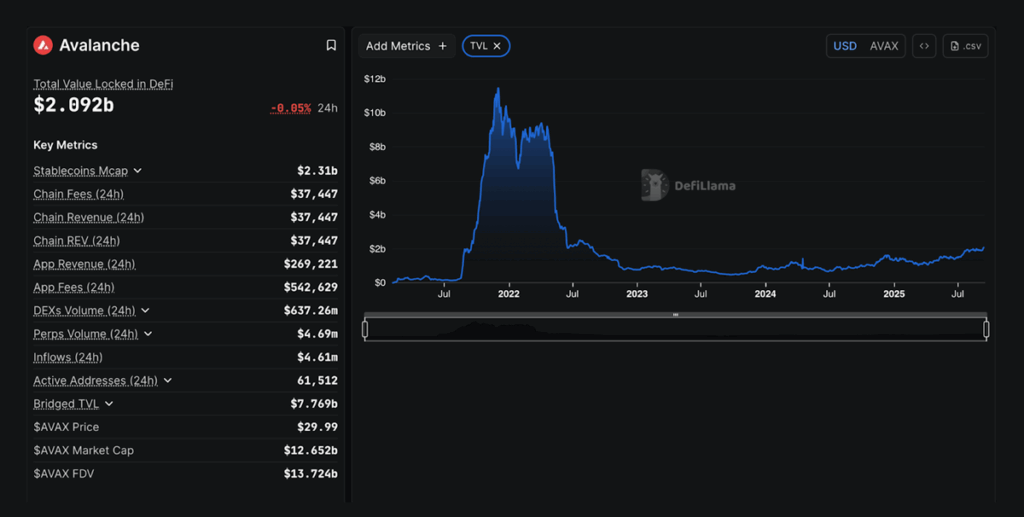
Avalanche total value locked. Source: DeFiLlama
$LIVE Presale Offers 12x on Launch and M2E Crypto Rewards
The $LIVE crypto presale is currently trading at $0.02 with a launch price of $0.25, offering just over 12x potential returns for presale buyers. The presale is slightly different from the standard presale model, where users simply swap BTC, ETH, or USDC for tokens. Instead, buyers can purchase bundles that include a token allocation, an NFT key to access a virtual giveaway, bonus mining allocations, and a physical wristband that unlocks the LivLive AR world.
LivLive is an augmented reality ecosystem that merges AI, blockchain, and gamification to reward real-world actions with M2E crypto prizes. Players armed with the app synced LivLive wristbands can complete quests such as posting service reviews, visiting their favourite shops, or conquering gym sessions to earn $LIVE tokens and real-world assets (RWAs). Businesses and brands also benefit by launching quests that serve as interactive and verifiable marketing campaigns.
The $LIVE token follows a transparent distribution model with a hard-capped supply of 5 billion. New supply is introduced post-launch through mining allocations tied to presale bundles, incentivizing activity and ensuring a sustainable economy.
For example, the $250 IGNITE bundle includes 12,500 tokens plus a 140 percent mining bonus of 17,500 tokens, totaling 30,000 tokens. At the launch price of $0.25, this allocation could be worth $7,500, representing a 30x return.
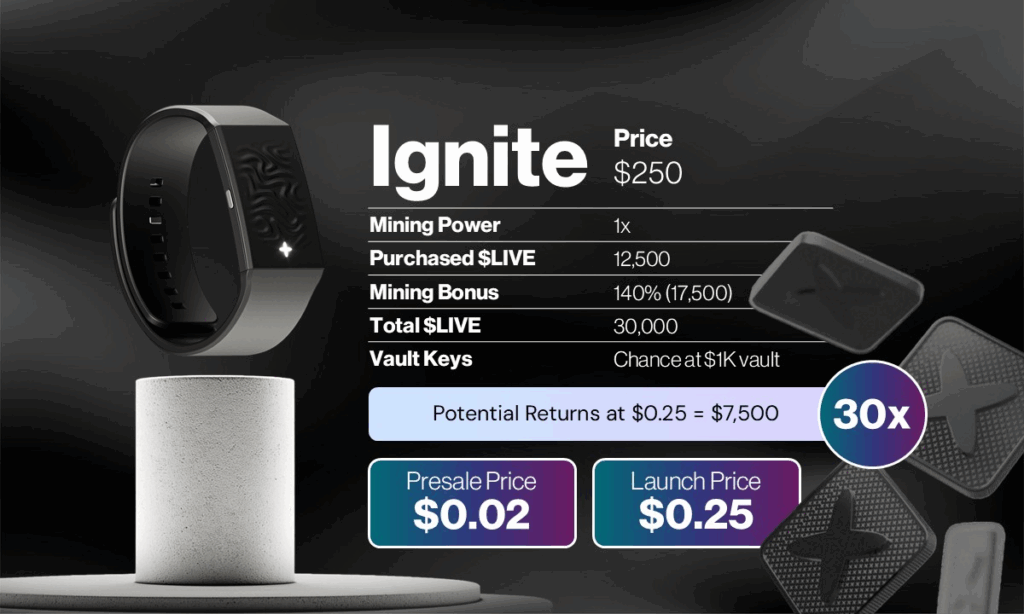
LivLive’s Business Integration: Driving Demand for $LIVE
The $LIVE token will act as a means of exchange across the LivLive ecosystem, where businesses, brands, and users interact through quests and events. The idea of the LivLive AR gamified world is to give businesses the opportunity to launch interactive and verifiable marketing campaigns that players enjoy participating in while earning crypto rewards.
The LivLive protocol integrates AI, move-to-earn (M2E) mechanics, gamification, and proof-of-presence wristbands to ensure that campaigns are both authentic and effective. Businesses can create in-game quests, such as rewarding users for visiting a new café, attending a fitness class, or leaving a review at a local bar.
Players completing M2E crypto quests verify their presence through their wristbands, while AI ensures that quests and rewards are personalized to user behavior. To run these campaigns, businesses will need to buy and use $LIVE tokens, creating ongoing demand and adding real economic value to the ecosystem.
Final Thoughts on the AVAX Trading Action and $LIVE Presale
The AVAX trading action has been positive for several months now, marking a huge change in sentiment since the 2022 bear market pushed the layer-1 crypto under $10. Whether AVAX can hit $50 this year is hard to predict, but most price prediction experts believe that it is unlikely.
The $LIVE presale has positioned itself as the leading crypto in the AR and M2E market, offering real utility and opportunities to traders, Web3 gamers, and businesses. The $LIVE token is trading for $0.02 with a launch price of $0.25, offering a potential 12x return.
The U.S. market is set to welcome its first exchange-traded funds (ETFs) based on XRP and Dogecoin, marking a milestone for altcoin investment products.
Fund issuer REX-Osprey confirmed that the XRP ETF is expected to debut this week, while a Dogecoin ETF will follow shortly after.
XRP ETF to Trade Under XRPR
The REX-Osprey XRP ETF, set to trade under the ticker XRPR, will provide spot exposure to XRP, currently the third-largest cryptocurrency by market capitalization.
The fund has cleared the Securities and Exchange Commission’s (SEC) 75-day review window and is slated to begin trading on Friday, barring unforeseen delays.
The launch falls under the Investment Company Act of 1940, which allows funds to automatically take effect after 75 days unless the SEC raises objections.
This pathway differs from the Securities Act of 1933, which governs spot Bitcoin ETFs and involves a more complex approval process.
Market Views and Demand
Industry experts see the launch as a key test for demand.
“This will be another good litmus test for ‘33 Act spot XRP ETF demand,” said Nate Geraci, President of ETF consultancy Nova Dius.
He noted that futures-based XRP ETFs are already nearing $1 billion in assets.
Dogecoin ETF Follows Suit
Dogecoin is also set for its first U.S.-listed ETF.
“As of now, the Doge ETF DOJE is slated for a Thursday launch,” Bloomberg ETF analyst Eric Balchunas said.
The REX-Osprey Dogecoin ETF will also operate under the 1940 Act framework.
It marks the first memecoin ETF in the country and reflects growing acceptance of alternative cryptocurrencies in mainstream investment channels.
Track Record and Other Products
REX-Osprey has been active in the altcoin ETF space.
In July, the company launched a Solana staking ETF, though investor appetite has been limited, with just $274 million in assets since launch.
In late August, REX-Osprey also filed for a BNB staking ETF.
A Pipeline of Crypto ETFs
The new launches are part of a broader wave of crypto ETFs under review.
According to Bloomberg analyst James Seyffart, more than 90 such products are currently awaiting SEC approval.
Among them is Canary Capital’s Litecoin ETF, which is expected to receive a final decision in early October.
Bitwise has also filed for a spot Avalanche ETF, joining VanEck and Grayscale as contenders for approval.
However, the SEC has delayed decisions on other filings, including Bitwise’s Dogecoin ETF and Grayscale’s Hedera ETF, extending deadlines until November 12.
The imminent arrival of XRP and Dogecoin ETFs is expected to set the tone for how regulators and investors approach the next wave of altcoin investment vehicles.
Bitcoin entered the new trading week under pressure, with prices circling weekend lows of around $115,000 as investors looked ahead to a pivotal U.S. Federal Reserve meeting.
The world’s largest cryptocurrency avoided sharp volatility but remained on watch for signals that could shape its near-term direction.
Cautious Market Moves
Data from TradingView showed Bitcoin dropping toward $115,000 after peaking at $116,800 during Friday’s Wall Street session — its highest level since late August.
“Pretty clear price is being walked down here yet again going into a new week,” trader Skew wrote on X, adding that there was “some pretty decent bid depth & liquidity just below $115K.”
“Time to pay attention,” he concluded.
Other analysts emphasized that Bitcoin’s short-term goal was not a breakout, but rather regaining stability at key support levels.
Traders Focus on $114K Support
Popular analyst Rekt Capital explained that the immediate task was for Bitcoin to reclaim $114,000 as a firm base.
“The goal isn’t for Bitcoin to break $117k in the short-term,” he wrote.
“The goal is for Bitcoin to reclaim $114k into support first. Because that’s what would enable the premium-buying necessary to get price above $117k later on.”
Despite short-term uncertainty, Rekt Capital maintained that Bitcoin’s bull market remained intact and that fresh all-time highs were likely still ahead.
He added that a weekly close above $114,000 would be considered “bullish.”
Fed Rate Cut Expectations Dominate
Beyond Bitcoin, the spotlight was firmly on the Federal Reserve’s upcoming policy decision.
Markets were near-unanimous in predicting a 0.25% rate cut, a move that could further support risk assets, including cryptocurrencies.
Analysts argued that improving U.S. economic data, looser financial conditions, and broad participation from cyclical industries all point to continued economic expansion.
In a recent update, trading firm Mosaic Asset Company struck an optimistic tone.
“The combination of improving leading indicators, ongoing loose financial conditions, and strong market breadth that includes participation by cyclical industries favors an ongoing economic expansion in my opinion,” its author wrote.
“That supports the earnings outlook which is ultimately good for stock prices at the same time the Fed is set to resume rate cuts. That could make for an excellent trading environment into next year.”
Dogecoin has staged a powerful rally, gaining nearly 40% in just seven days, far outperforming the wider cryptocurrency market, which rose around 8% in the same timeframe.
The price of DOGE now sits close to $0.296, up from $0.21 earlier this month, as traders point to strong technical and onchain signals suggesting further growth.
Bullish Technical Breakout
On the weekly chart, Dogecoin has broken out of a multimonth symmetrical triangle, a continuation pattern that typically signals further upside.
Trading volumes surged during the breakout, more than tripling compared to average levels, indicating strong momentum behind the move.
Chart projections suggest Dogecoin could rise as high as $0.60, a gain of about 95% from current levels, by October.
Some analysts, including CryptoKing and CryptoGoos, have issued more conservative targets near $0.45, which aligns with resistance from a broader multiyear triangle.
Key Support Levels to Watch
Dogecoin’s relative strength index (RSI) remains below the overbought threshold of 70, giving bulls further room to push higher.
Still, traders warn that DOGE must hold above its 50-week exponential moving average, currently near $0.227, to sustain the bullish setup.
A decisive drop below this level could trigger a deeper correction toward the 200-week EMA around $0.215.
Signs of More Growth Potential
Beyond technical patterns, onchain indicators point to additional upside.
Dogecoin’s MVRV Z-Score, which measures whether an asset is over- or undervalued compared to historical holder costs, currently sits at 1.35.
In past cycles, similar readings have preceded major rallies, including last November’s 230% surge.
By contrast, extreme highs — such as the Z-Score exceeding 20 during DOGE’s all-time peak near $0.70 in 2021 — signaled overheated conditions.
The modest current reading suggests that investors are not sitting on excessive unrealized profits, leaving more room for price appreciation.
Can Dogecoin Repeat Historic Rallies?
With momentum building, comparisons are being made to past explosive moves, particularly last year’s triple-digit surge.
Analysts say the current setup leaves open the possibility of another significant rally if key supports hold and broader crypto sentiment remains positive.
While risks remain — including sudden market corrections and broader macroeconomic factors — Dogecoin’s breakout has strengthened the case for further gains in the coming weeks.

